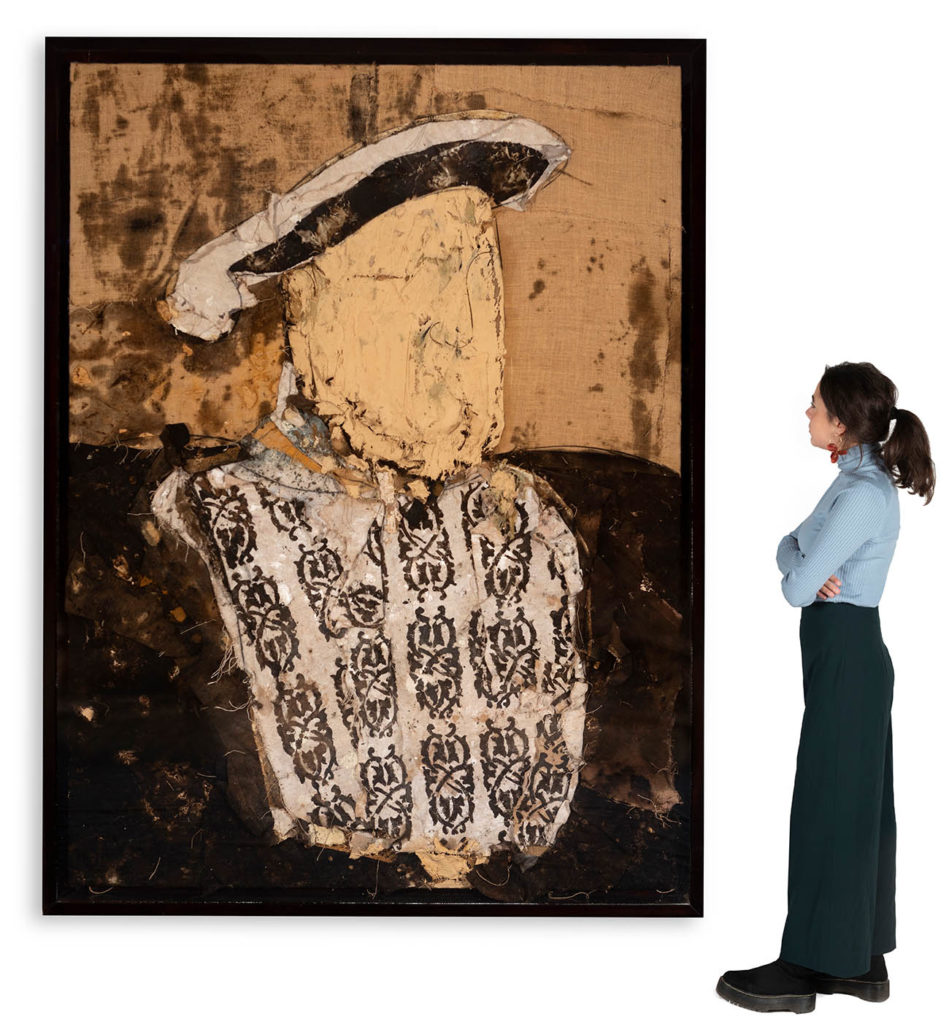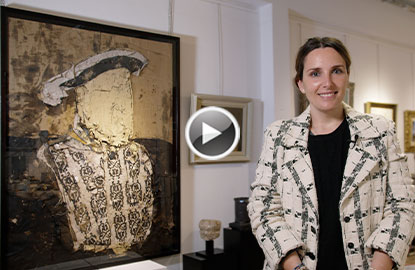Manolo Valdés, Portrait of Enrique VIII at auction in January.
The famous portrait of the British monarch Henry VIII, painted by Hans Holbein the Younger around 1537, was reinterpreted by Manolo Valdés in 1991, daringly subjecting it to a painstaking process of plastic purification.
In those years, Valdés was in a particularly fruitful stage, in which he made a series of tributes to Renaissance and Baroque artists, focusing on the portraits of kings and courtiers that they commissioned. In this case, we recognize Holbein’s painting, despite the fact that the monarch’s features disappear under synthetic brushstrokes aimed at economizing forms and abstracting the essential. The chromatic reduction, with a palette in which earthy tones predominate, accompanies the formal synthesis. In this way, the figure is endowed with a spectral intensity, as an archetype loaded with symbolism. The chamber painters recorded a long history of formalities in the representation of power, which particularly interested Valdés.
The paintings and engravings of Manolo Valdés show a deep knowledge and a frank admiration for the great masters, from whom he freely took what he considered appropriate instead of contemplating them on their throne, as untouchables. Reinterpreting, versioning and recreating was his motto.
MANOLO VALDÉS BLASCO (Valencia, 1942) was the introducer in Spain of a form of artistic expression that combines political and social commitment with humor and irony. He began his training in 1957, the year in which he entered the School of Fine Arts of San Carlos de Valencia. However, two years later he left his studies to dedicate himself fully to painting. In 1964 he founded the artistic group Equipo Crónica, together with Juan Antonio Toledo and Rafael Solbes, in which he remained until the latter’s death in 1981, despite the fact that Toledo had left the group two years after its foundation. Since then he has settled in New York, the city where he currently resides and where he has continued to experiment with new forms of expression, including sculpture. Among the many awards that Manolo Valdés has obtained, the Lissone and Biella of Milan (1965), the silver medal of the II International Biennial of Engravings in Tokyo (1979), the prize of the Bridgestone Museum of Art in Lisbon (1979) , the National Prize of Plastic Arts (1983), the medal of the International Festival of Plastic Artists of Bagdad (1986), the Decoration of the Order of Andrés Bello in Venezuela (1993), the prize of the National Council of Monaco (1997), the Gold Medal for Merit in Fine Arts (1998), the Prize from the Spanish Association of Art Critics (2000) and the Prize for the Best Print Artist (2002), among others. With Equipo Crónica, Valdés used figuration as a vehicle of expression for his approaches, for his criticisms of art, society and politics, but prioritizing the pure act of painting above any other content. From the thematic point of view, Valdés is inspired by the art of the great masters of painting: Goya, Velázquez, El Greco, Ribera or Zurbarán, and never hides his models, but rather underlines them, even in the titles of his work. Formally, he does a large-format work in which the lights and colors express tactile values, due to the treatment given to the materials. Her work forces the observer to inquire into memory and look for significant images from art history. Valdés is represented in some of the most prominent museums around the world, such as the Reina Sofía in Madrid, the Metropolitan, MoMA and the Guggenheim in New York, the Georges Pompidou Center and the Fons National d’Arts Plastiques in Paris, the Kusnthalle in Hamburg, the Kunstmuseum in Berlin and the Museum of Fine Arts in Bilbao, among many others.




